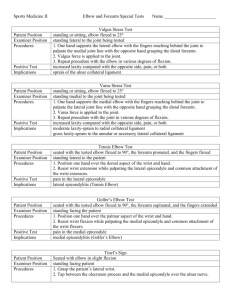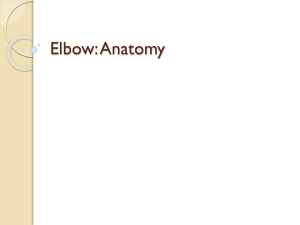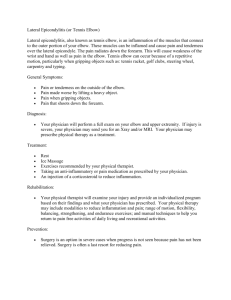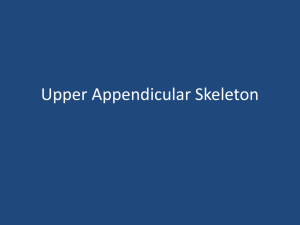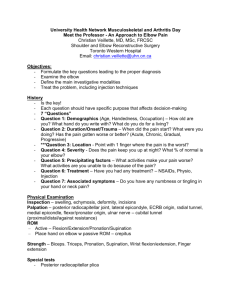Elbow Injuries
advertisement
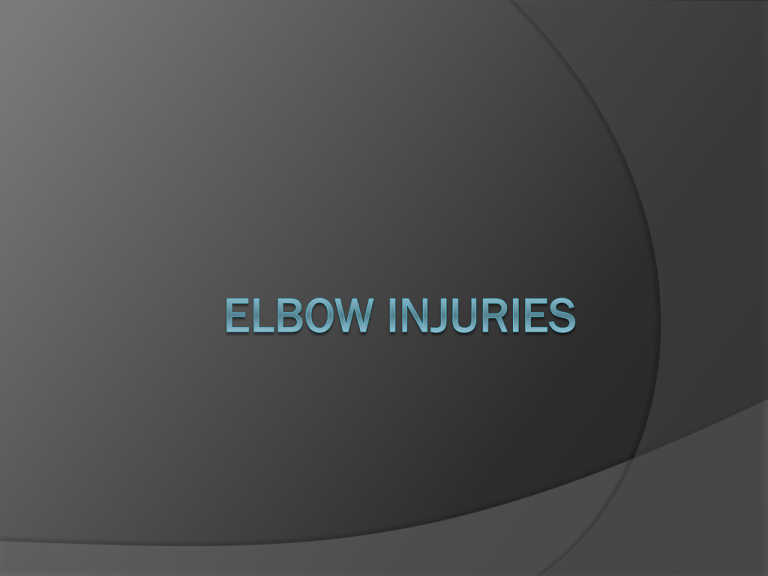
FYI Functions with any upper extremity movement. Prone to muscle and tendon injuries because it is the sight of many muscle attachments. Anatomy Hinge joint 3 major bones: humerus, radius, and ulna. Ulna is hooked to the end of the humerus and forms a tight joint. Radius is on the thumb side of the forearm. Able to rotate, causing supination and pronation of the forearm. Ligaments Joint capsule (a ligament) surrounds the elbow and gives some general stability to the joint. Other primary ligaments that provide stability: Ulnar collateral-stabilize the medial aspect Radial collateral-stabilize the lateral aspect Annular collateral-helps hold the radius and ulna together near the elbow joint ○ Interosseus membrane-tissue that joins the radius and ulna from the elbow to wrist and keeps the two bones from separating. Muscles Triceps-primarily performs elbow extension Biceps-primarily performs elbow flexion. Wrist flexors-attach to the medial epicondyle of humerus Wrist extensors-attach to the lateral epicondyle of humerus **epicondyle-rounded articular area. **both muscles help stabilize the elbow. Preventing Elbow Injuries Not a frequently injured joint. Most injuries seen at the elbow joint are caused by overuse. Most athletes pay more attention to strengthening the biceps and triceps, and they fail to properly condition some of the smaller muscles of the wrist (vital to preventing overuse injuries). Ligament Injuries Sprains classified as first, second, or third degree. Ulnar collateral seem to be more prone to sprains than the other ligaments Especially in athletes who throw, due to the amount of stress placed on the medial aspect of the elbow. Valgus Stress Forcing the medial aspect of the joint to separate or spread apart as the forearm moves laterally Characterized by medial elbow pain and swelling. Joint laxity may be present. Treated using PRICE Rehab: strengthening the wrist flexors Radial Collateral Injuries Very rare Same characteristics of ulnar collateral injuries except the pain and swelling would be on the lateral side. Rehab: strengthening the wrist extensors Muscle and Tendon Injuries Strains often caused by either excessive resistive forces or overuse. Can occur to elbow flexors or extensors, as well as to the wrist flexors and wrist extensors Elbow Flexor Strain Often caused by a loaded movement that includes the elbow and shoulder together. “two-joint muscles” are very prone to strains. Muscles involved with creating movement at more than one joint Ex. Biceps-flexes elbow and shoulder Degrees of a Flexor Strain Minor-characterized by discomfort at the anterior aspect of the elbow and minimal swelling. Some weakness when elbow flexion is resisted. Moderate-mild to moderate amounts of swelling and marked weakness. **treated with PRICE Complete rupture needs to be referred to team physician Elbow Extensor Strain Excessive resistance to the triceps muscle will often cause tissue damage to the elbow extensors. Needs to be assessed carefully because the triceps tendon can often pull a bit of bone away from the ulna. Characteristics are the same as a flexor strain except the pain will be at the posterior aspect. Treatment: PRICE Wrist Flexor Strains Caused by excessive resistance during wrist flexion movements or from overuse. Result in pain over the medial epicondyle of the humerus or the front of the forearm. Treated with PRICE and activity should be modified Wrist Extensor Strains Caused by excessive resistance during wrist extension movements or overuse Result in pain over the lateral epicondyle of the humerus. Treated with PRICE and activity should be modified. Lateral Epicondylitis Caused by poor mechanics and continual use over a long period of time. Racquet sports are the most common cause Aka Tennis Elbow Characterized by pain over the lateral epicondyle of the humerus and minimal swelling. Treatment: PRICE, a support, and limiting activity Medial Epicondylitis Not as common as lateral epicondylitis. Often a result of repetitive throwing. Aka “Little League elbow” Treatment: PRICE and limiting activities. Bone Injuries Fractures to the distal end of the humerus are not common. If they do occur, it is often due to a very powerful mechanism Ex. Hand being planted on the ground and someone forcing the arm into excessive side bending. ATC must consider any type of elbow fracture an emergency because they can result in compression of an artery or nerve Epiphyseal and Avulsion Fractures More common on the medial eipcondyle or olecranon aspect Olecranon-process of the ulna projecting behind the elbow joint. Epiphyseal injury suspected whenever there is swelling, pain, and loss of movement. Severe pain and deformity indicate an avulsion fracture. Either injury should be referred to a team physician Ulna Dislocation Elbow is one of the most commonly dislocated joints in the body. Takes a very traumatic injury to dislocate the ulna from the humerus. Violent hyperextension or a severe blow to the lateral aspect of the elbow Obvious deformity Should be immediately splinted in the position in which it is found Needs to be reduced by a physician Olecranon Bursitis Happens when the olecranon process is contused. Olecranon bursa becomes irritated Causes a lot of fluid to build up at the “tip” of the elbow Rarely disabling, but build up can become the size of a golf ball. Treatment: compression wrap or may need to be drained. Padding may need to be applied to protect the elbow from further bruising. Pics of olecranon bursitis
